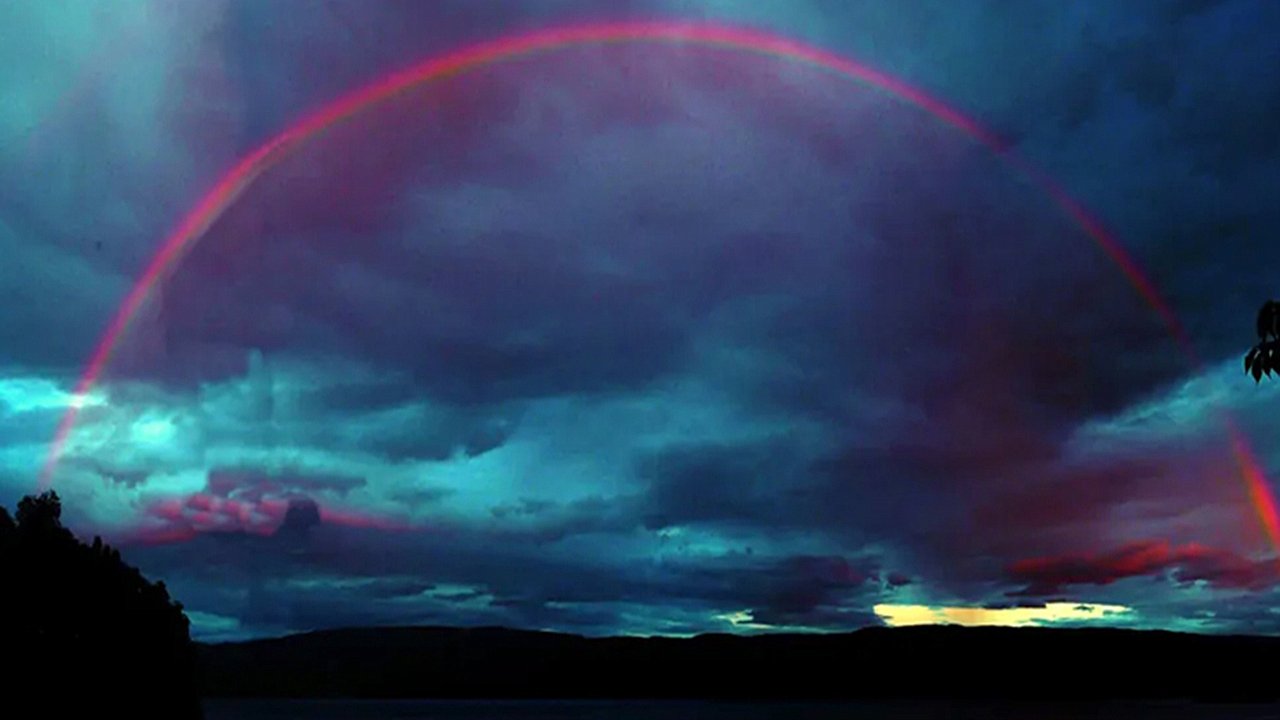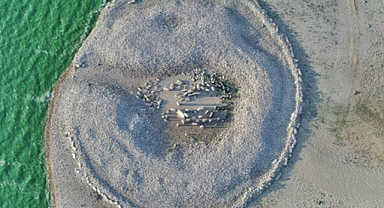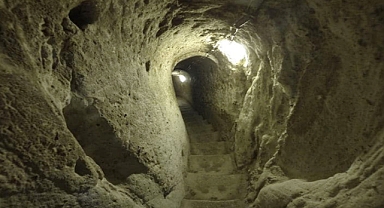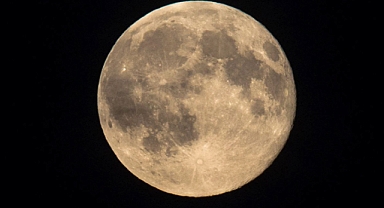Just like their daytime counterparts, moonbows form when light is refracted, reflected, and dispersed through water droplets in the atmosphere, such as those from rain or mist. However, in the case of moonbows, the light source is the Moon instead of the Sun. They always appear opposite the Moon in the sky from the observer’s point of view.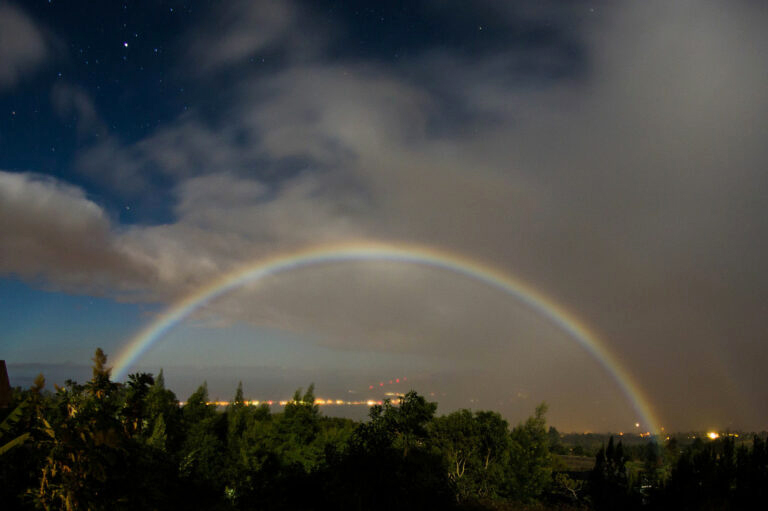 Moonbows have been documented since ancient times, with references found as far back as Aristotle’s Meteorology around 350 BC. But they’re far less common and much harder to spot than regular rainbows. That’s because the Moon reflects only a fraction of the sunlight the Sun emits, making moonbows significantly fainter. Our eyes struggle to detect the full spectrum of colors at such low light levels, which is why moonbows usually appear white or colorless to the naked eye. However, long-exposure photographs can reveal their true, delicate rainbow hues.To witness a moonbow, several conditions must align perfectly. First, the Moon must be nearly full—or at its brightest phase—and free from cloud cover. Second, the Moon needs to be low in the sky, ideally at an elevation of 42 degrees or less. Third, the surrounding sky must be dark enough, which typically means moonbows can only be seen two to three hours after sunset or before sunrise. Finally, there must be moisture in the air—rainfall, mist, fog, or spray—all located opposite the Moon.
Moonbows have been documented since ancient times, with references found as far back as Aristotle’s Meteorology around 350 BC. But they’re far less common and much harder to spot than regular rainbows. That’s because the Moon reflects only a fraction of the sunlight the Sun emits, making moonbows significantly fainter. Our eyes struggle to detect the full spectrum of colors at such low light levels, which is why moonbows usually appear white or colorless to the naked eye. However, long-exposure photographs can reveal their true, delicate rainbow hues.To witness a moonbow, several conditions must align perfectly. First, the Moon must be nearly full—or at its brightest phase—and free from cloud cover. Second, the Moon needs to be low in the sky, ideally at an elevation of 42 degrees or less. Third, the surrounding sky must be dark enough, which typically means moonbows can only be seen two to three hours after sunset or before sunrise. Finally, there must be moisture in the air—rainfall, mist, fog, or spray—all located opposite the Moon.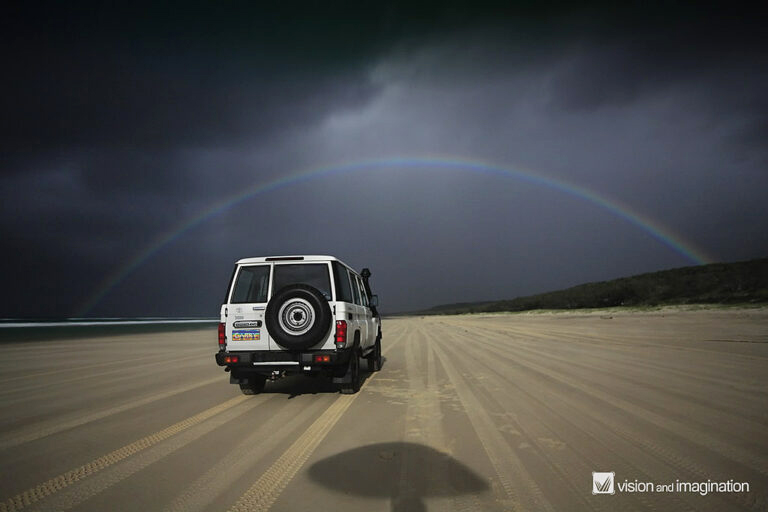 Because of this very specific combination of requirements, moonbows are much rarer than sunlit rainbows, occurring less than 10% as often. They are more likely to be seen near full moonrises during winter at high latitudes, when the skies are darker and precipitation more frequent. The appearance of color in a moonbow is also influenced by the size of the water droplets: the smaller the droplets, the less vivid the colors will be.While rare, there are certain places around the world where moonbows are known to occur more frequently. In the United States, you can spot them at natural sites with heavy mist or spray, such as Yosemite National Park in California, Niagara Falls in New York, and Cumberland Falls near Corbin, Kentucky—which is sometimes nicknamed “Moonbow Falls.” Victoria Falls, located on the border of Zambia and Zimbabwe, is another famous destination for capturing stunning spray-induced moonbows.If you’re hoping to catch a glimpse of a moonbow, your best chance is during summer full moons in mid-latitudes, when the Moon stays lower in the sky for longer periods. In other seasons, moonbows may only be visible for an hour or so. Even if you can’t see the colors with your eyes, try pointing a camera with a long exposure toward the mist—what looks faint in person may come alive in photos.
Because of this very specific combination of requirements, moonbows are much rarer than sunlit rainbows, occurring less than 10% as often. They are more likely to be seen near full moonrises during winter at high latitudes, when the skies are darker and precipitation more frequent. The appearance of color in a moonbow is also influenced by the size of the water droplets: the smaller the droplets, the less vivid the colors will be.While rare, there are certain places around the world where moonbows are known to occur more frequently. In the United States, you can spot them at natural sites with heavy mist or spray, such as Yosemite National Park in California, Niagara Falls in New York, and Cumberland Falls near Corbin, Kentucky—which is sometimes nicknamed “Moonbow Falls.” Victoria Falls, located on the border of Zambia and Zimbabwe, is another famous destination for capturing stunning spray-induced moonbows.If you’re hoping to catch a glimpse of a moonbow, your best chance is during summer full moons in mid-latitudes, when the Moon stays lower in the sky for longer periods. In other seasons, moonbows may only be visible for an hour or so. Even if you can’t see the colors with your eyes, try pointing a camera with a long exposure toward the mist—what looks faint in person may come alive in photos.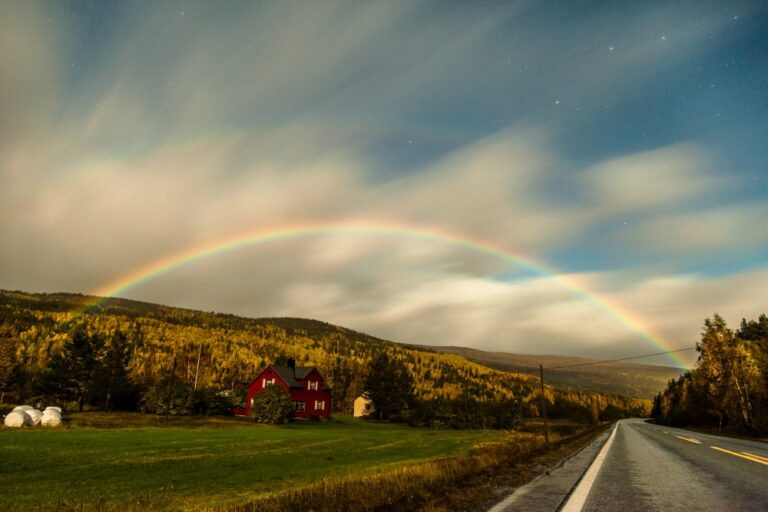 So next time you find yourself under a bright, low-hanging full moon after a rain shower or near a misty waterfall, take a moment to look opposite the Moon—you just might catch a glimpse of one of nature’s most magical secrets: the moonbow.
So next time you find yourself under a bright, low-hanging full moon after a rain shower or near a misty waterfall, take a moment to look opposite the Moon—you just might catch a glimpse of one of nature’s most magical secrets: the moonbow.
 Moonbows have been documented since ancient times, with references found as far back as Aristotle’s Meteorology around 350 BC. But they’re far less common and much harder to spot than regular rainbows. That’s because the Moon reflects only a fraction of the sunlight the Sun emits, making moonbows significantly fainter. Our eyes struggle to detect the full spectrum of colors at such low light levels, which is why moonbows usually appear white or colorless to the naked eye. However, long-exposure photographs can reveal their true, delicate rainbow hues.To witness a moonbow, several conditions must align perfectly. First, the Moon must be nearly full—or at its brightest phase—and free from cloud cover. Second, the Moon needs to be low in the sky, ideally at an elevation of 42 degrees or less. Third, the surrounding sky must be dark enough, which typically means moonbows can only be seen two to three hours after sunset or before sunrise. Finally, there must be moisture in the air—rainfall, mist, fog, or spray—all located opposite the Moon.
Moonbows have been documented since ancient times, with references found as far back as Aristotle’s Meteorology around 350 BC. But they’re far less common and much harder to spot than regular rainbows. That’s because the Moon reflects only a fraction of the sunlight the Sun emits, making moonbows significantly fainter. Our eyes struggle to detect the full spectrum of colors at such low light levels, which is why moonbows usually appear white or colorless to the naked eye. However, long-exposure photographs can reveal their true, delicate rainbow hues.To witness a moonbow, several conditions must align perfectly. First, the Moon must be nearly full—or at its brightest phase—and free from cloud cover. Second, the Moon needs to be low in the sky, ideally at an elevation of 42 degrees or less. Third, the surrounding sky must be dark enough, which typically means moonbows can only be seen two to three hours after sunset or before sunrise. Finally, there must be moisture in the air—rainfall, mist, fog, or spray—all located opposite the Moon. Because of this very specific combination of requirements, moonbows are much rarer than sunlit rainbows, occurring less than 10% as often. They are more likely to be seen near full moonrises during winter at high latitudes, when the skies are darker and precipitation more frequent. The appearance of color in a moonbow is also influenced by the size of the water droplets: the smaller the droplets, the less vivid the colors will be.While rare, there are certain places around the world where moonbows are known to occur more frequently. In the United States, you can spot them at natural sites with heavy mist or spray, such as Yosemite National Park in California, Niagara Falls in New York, and Cumberland Falls near Corbin, Kentucky—which is sometimes nicknamed “Moonbow Falls.” Victoria Falls, located on the border of Zambia and Zimbabwe, is another famous destination for capturing stunning spray-induced moonbows.If you’re hoping to catch a glimpse of a moonbow, your best chance is during summer full moons in mid-latitudes, when the Moon stays lower in the sky for longer periods. In other seasons, moonbows may only be visible for an hour or so. Even if you can’t see the colors with your eyes, try pointing a camera with a long exposure toward the mist—what looks faint in person may come alive in photos.
Because of this very specific combination of requirements, moonbows are much rarer than sunlit rainbows, occurring less than 10% as often. They are more likely to be seen near full moonrises during winter at high latitudes, when the skies are darker and precipitation more frequent. The appearance of color in a moonbow is also influenced by the size of the water droplets: the smaller the droplets, the less vivid the colors will be.While rare, there are certain places around the world where moonbows are known to occur more frequently. In the United States, you can spot them at natural sites with heavy mist or spray, such as Yosemite National Park in California, Niagara Falls in New York, and Cumberland Falls near Corbin, Kentucky—which is sometimes nicknamed “Moonbow Falls.” Victoria Falls, located on the border of Zambia and Zimbabwe, is another famous destination for capturing stunning spray-induced moonbows.If you’re hoping to catch a glimpse of a moonbow, your best chance is during summer full moons in mid-latitudes, when the Moon stays lower in the sky for longer periods. In other seasons, moonbows may only be visible for an hour or so. Even if you can’t see the colors with your eyes, try pointing a camera with a long exposure toward the mist—what looks faint in person may come alive in photos. So next time you find yourself under a bright, low-hanging full moon after a rain shower or near a misty waterfall, take a moment to look opposite the Moon—you just might catch a glimpse of one of nature’s most magical secrets: the moonbow.
So next time you find yourself under a bright, low-hanging full moon after a rain shower or near a misty waterfall, take a moment to look opposite the Moon—you just might catch a glimpse of one of nature’s most magical secrets: the moonbow.